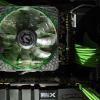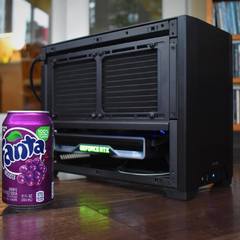-
Posts
5,998 -
Joined
-
Last visited
Reputation Activity
-
 TechFan@ic got a reaction from Latvian Video in Experiences with non-techies
TechFan@ic got a reaction from Latvian Video in Experiences with non-techies
This is actually horrible. -

-
 TechFan@ic got a reaction from Mat_95 in What is asic-quality?
TechFan@ic got a reaction from Mat_95 in What is asic-quality?
This was told to me by a graphics Engineer from XFX , I personally did not investigate it, but I would deem a graphics engineer trust worthy enough to take his word for it.
Also higher ASIC quality means the chip requires less voltage to run at the default specifications thus generating less heat, but it also means that the voltage limit is lower & voltage response is weaker.
-

-
 TechFan@ic got a reaction from documnt in The Water Cooling Gallery
TechFan@ic got a reaction from documnt in The Water Cooling Gallery
I would've liked this but the lazy tubing and the apple logo really put me off . -
.png) TechFan@ic got a reaction from 50Shades in The Water Cooling Gallery
TechFan@ic got a reaction from 50Shades in The Water Cooling Gallery
I would've liked this but the lazy tubing and the apple logo really put me off . -

-
 TechFan@ic got a reaction from Vic0630 in Intel & AMD, Architectural Discussion, How Far Ahead Is Intel ?
TechFan@ic got a reaction from Vic0630 in Intel & AMD, Architectural Discussion, How Far Ahead Is Intel ?
Well guys I've been doing my own research & analysis of the performance of AMD & Intel CPUs for sometime, I did not do tests personally however I tried to salvage as much knowledge as possible to try and answer a question that has been on my mind, which is how far ahead Intel really is? and that question led me to some very interesting realizations.
The discussion will be highly technical and might seem boring to some, I'll start off with the basics & end with the answer to the original question plus several others.
Ok let's begin, first off our discussion will be surrounding AMD's modular Bulldozer/Piledriver architecture & Intel's core series from Westmere to Sandy/Ivy & Haswell.
The Architectures : AMD Bulldozer/Piledriver
The building block of AMD's modular architecture is not an x86 core, it's an x86 module, this module contains everything that a core contains but with a number of components doubled, these components include the integer scheduler, its datapath, 16KB of L1 DCache & it's own load/store unit.
The doubling of these components is what gives the AMD module essentially two cores/threads.
The integer cores share the early pipeline stages (e.g. L1i, fetch, decode), the floating point unit, and the L2 cache with the rest of the module.
How this affects performance
Depending on the workload the quad module eight core AMD processors can either perform as eight processing units or as four and this depends entirely on the affinity of the workload to integer or floating point calculations.
If integer calculations are needed there are eight integer pipelines that can be used, however if floating point calculations are needed there are only four.
-
 TechFan@ic got a reaction from M.C.Edgy in Intel & AMD, Architectural Discussion, How Far Ahead Is Intel ?
TechFan@ic got a reaction from M.C.Edgy in Intel & AMD, Architectural Discussion, How Far Ahead Is Intel ?
Well guys I've been doing my own research & analysis of the performance of AMD & Intel CPUs for sometime, I did not do tests personally however I tried to salvage as much knowledge as possible to try and answer a question that has been on my mind, which is how far ahead Intel really is? and that question led me to some very interesting realizations.
The discussion will be highly technical and might seem boring to some, I'll start off with the basics & end with the answer to the original question plus several others.
Ok let's begin, first off our discussion will be surrounding AMD's modular Bulldozer/Piledriver architecture & Intel's core series from Westmere to Sandy/Ivy & Haswell.
The Architectures : AMD Bulldozer/Piledriver
The building block of AMD's modular architecture is not an x86 core, it's an x86 module, this module contains everything that a core contains but with a number of components doubled, these components include the integer scheduler, its datapath, 16KB of L1 DCache & it's own load/store unit.
The doubling of these components is what gives the AMD module essentially two cores/threads.
The integer cores share the early pipeline stages (e.g. L1i, fetch, decode), the floating point unit, and the L2 cache with the rest of the module.
How this affects performance
Depending on the workload the quad module eight core AMD processors can either perform as eight processing units or as four and this depends entirely on the affinity of the workload to integer or floating point calculations.
If integer calculations are needed there are eight integer pipelines that can be used, however if floating point calculations are needed there are only four.
-
.png)
-
 TechFan@ic got a reaction from Chrysolite in Experiences with non-techies
TechFan@ic got a reaction from Chrysolite in Experiences with non-techies
This is actually horrible. -
 TechFan@ic got a reaction from Belgarathian in Experiences with non-techies
TechFan@ic got a reaction from Belgarathian in Experiences with non-techies
This is actually horrible. -

-
 TechFan@ic got a reaction from Shahnewaz in Nvidia's "Tier 0" Program Is Behind The Origin PC Debacle.
TechFan@ic got a reaction from Shahnewaz in Nvidia's "Tier 0" Program Is Behind The Origin PC Debacle.
More has come out about the alleged Nvidia-OriginPC deal to forgo the selling of AMD GPUs.
An Nvidia sales program code named "Tier 0" is behind it all and the Nvidia Board of Directors do not like it one bit.
Heads will likely roll after the dust settles because of this, due to the illegal nature of what took place either some folks at Nvidia will lose their jobs, Nvidia will lose a lot of money or both.
"Tier 0" is still in effect & the plan was for it to be rolled out to other vendors as well.
The gist of the program is :
Source
-

-
 TechFan@ic got a reaction from dimitriianghelov in Intel & AMD, Architectural Discussion, How Far Ahead Is Intel ?
TechFan@ic got a reaction from dimitriianghelov in Intel & AMD, Architectural Discussion, How Far Ahead Is Intel ?
Well guys I've been doing my own research & analysis of the performance of AMD & Intel CPUs for sometime, I did not do tests personally however I tried to salvage as much knowledge as possible to try and answer a question that has been on my mind, which is how far ahead Intel really is? and that question led me to some very interesting realizations.
The discussion will be highly technical and might seem boring to some, I'll start off with the basics & end with the answer to the original question plus several others.
Ok let's begin, first off our discussion will be surrounding AMD's modular Bulldozer/Piledriver architecture & Intel's core series from Westmere to Sandy/Ivy & Haswell.
The Architectures : AMD Bulldozer/Piledriver
The building block of AMD's modular architecture is not an x86 core, it's an x86 module, this module contains everything that a core contains but with a number of components doubled, these components include the integer scheduler, its datapath, 16KB of L1 DCache & it's own load/store unit.
The doubling of these components is what gives the AMD module essentially two cores/threads.
The integer cores share the early pipeline stages (e.g. L1i, fetch, decode), the floating point unit, and the L2 cache with the rest of the module.
How this affects performance
Depending on the workload the quad module eight core AMD processors can either perform as eight processing units or as four and this depends entirely on the affinity of the workload to integer or floating point calculations.
If integer calculations are needed there are eight integer pipelines that can be used, however if floating point calculations are needed there are only four.
-
 TechFan@ic got a reaction from soja in Intel & AMD, Architectural Discussion, How Far Ahead Is Intel ?
TechFan@ic got a reaction from soja in Intel & AMD, Architectural Discussion, How Far Ahead Is Intel ?
Well guys I've been doing my own research & analysis of the performance of AMD & Intel CPUs for sometime, I did not do tests personally however I tried to salvage as much knowledge as possible to try and answer a question that has been on my mind, which is how far ahead Intel really is? and that question led me to some very interesting realizations.
The discussion will be highly technical and might seem boring to some, I'll start off with the basics & end with the answer to the original question plus several others.
Ok let's begin, first off our discussion will be surrounding AMD's modular Bulldozer/Piledriver architecture & Intel's core series from Westmere to Sandy/Ivy & Haswell.
The Architectures : AMD Bulldozer/Piledriver
The building block of AMD's modular architecture is not an x86 core, it's an x86 module, this module contains everything that a core contains but with a number of components doubled, these components include the integer scheduler, its datapath, 16KB of L1 DCache & it's own load/store unit.
The doubling of these components is what gives the AMD module essentially two cores/threads.
The integer cores share the early pipeline stages (e.g. L1i, fetch, decode), the floating point unit, and the L2 cache with the rest of the module.
How this affects performance
Depending on the workload the quad module eight core AMD processors can either perform as eight processing units or as four and this depends entirely on the affinity of the workload to integer or floating point calculations.
If integer calculations are needed there are eight integer pipelines that can be used, however if floating point calculations are needed there are only four.
-

-

-
 TechFan@ic got a reaction from Shakaza in G-Sync Vs FreeSync Event - July 18
TechFan@ic got a reaction from Shakaza in G-Sync Vs FreeSync Event - July 18
I'm going to make a big bold prediction and say G-Sync's going to win this one. Simply because most of the current 4K and IPS FreeSync monitors have very narrow variable ranges. 48-75, 40-60. The only exception is Asus's MG279Q.
-

-
 TechFan@ic got a reaction from BigDay in Is that a safe HD 7950 Vapor-X overclock?
TechFan@ic got a reaction from BigDay in Is that a safe HD 7950 Vapor-X overclock?
GCN based (7000 series) GPUs have a maximum voltage of 1.3v, stay below that and you're golden.
1.2v is a very moderate voltage, you will be totally fine.
-
 TechFan@ic got a reaction from squid4fl in NASA's Accidental Warp Field
TechFan@ic got a reaction from squid4fl in NASA's Accidental Warp Field
I remain very skeptical of this. Only a few years back scientists claimed to have measured a neutrino traveling at speed that surpasses that of light. It eventually turned out to be just an error.
Similarly in this instance measurements for the speed of some of the beams could simply be erroneous.
http://en.wikipedia.org/wiki/Faster-than-light_neutrino_anomaly.
-
 TechFan@ic got a reaction from SuperShires in How bad of shape is AMD really in?
TechFan@ic got a reaction from SuperShires in How bad of shape is AMD really in?
The answer to that deserves its own editorial. Maybe I'll write one some day.
But here's what happened in a nutshell. 2002 Jerry Sanders founder of AMD decided to retire after achieving the goal that everyone else believed impossible for decades. Beating Intel at their own game. At the time AMD was making record profit and revenue, thier CPUs were both faster and more efficient than their Intel counterparts and in two short years AMD controlled up to 50% market share in the x86 CPU business.
Hector Ruiz succeed Jerry as President and CEO. Ruiz decided that AMD should now involve itself in the graphics business. AMD began negotiating an acquisition between Nvidia and ATi. It was later decided that ATi should be acquired. AMD vastly overpayed for the acquisition. ATi was finally acquired for 6 Billion dollars in 2006, nearly what AMD is worth today.
Overbidding on ATi quickly began to show its financial effect on AMD, the company began to lose the momentum it once had. 1 billion dollar profits every year turned into 1 billion dollar losses.
Ruiz then decided to sell AMD's manufacturing to save the day, in 2008 AMD's manufacturing was spun off as Globalfoundries. Hector Ruiz was then quickly dispensed with after allegations of insider trading and after destroying what Jerry worked so hard to achieve in over three decades.
Dirk Meyer was hired to replace Ruiz. Meyer was a brilliant engineer and one of the two AMD engineering legends, the other being Jim Keller. Together with Keller, Myer contrived AMD's most successful CPU architectures in recent history, the original Athlon and the Athlon64. Under Meyer as CEO two CPU architectures were designed and introduced. A low power core code named Bobcat which was a resounding success and a high performance core code named Bulldozer which turned out to be a major flop.
Unfortunately the board of directors saw that Bulldozer flop as Meyer's fault. They pressured him to invade the mobile space with haste to redeem what they saw as his mistake. He however disagreed. He believed that AMD should first regain the strong foothold it once held against Intel in the market that AMD knows best, before attempting to break through an even tougher market that AMD had no previous experience in and a market that's controlled by multiple competitors just as strong as Intel. This disagreement spilled over to a disaster and Myer left in January of 2011.
8 months passed with no CEO leading AMD. Finally Rory Read was brought in by the board. He was seen as the hero that will resurrect AMD just as he helped Lenovo climb to the top. While Read was a brilliant manager he unfortunately had no prior experience in semiconductors. He was responsible for cancelling AMD's high performance CPU only designs. But he did bring Mark Papermaster on board as the Chief Technology Officer. Who by some miracle convinced Jim Keller to rejoin AMD and he's been designing AMD's future CPU architecture ever since.
The new CPU core will allegedly debut next year. AMD's long term x86 success relies entirely on this new core, code named Zen. So here's hoping for the best.
-
 TechFan@ic got a reaction from LukaP in NASA's Accidental Warp Field
TechFan@ic got a reaction from LukaP in NASA's Accidental Warp Field
I remain very skeptical of this. Only a few years back scientists claimed to have measured a neutrino traveling at speed that surpasses that of light. It eventually turned out to be just an error.
Similarly in this instance measurements for the speed of some of the beams could simply be erroneous.
http://en.wikipedia.org/wiki/Faster-than-light_neutrino_anomaly.




















